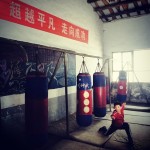 One way to globalize an art is to simplify it, give it rules that anyone can understand, and then submit it for an international review to the association most likely to be interested in the art. For martial arts, this process is known as sportification: Making the art of warfare and spiritual enlightenment into a game that anyone can play.
One way to globalize an art is to simplify it, give it rules that anyone can understand, and then submit it for an international review to the association most likely to be interested in the art. For martial arts, this process is known as sportification: Making the art of warfare and spiritual enlightenment into a game that anyone can play.
Sportification naturally divides the practitioners of any martial art into two opposing camps: purists who believe that simplification ruins and eventually mutates the art into something else; and pragmatists (for lack of a better word), who believe that without simplification and marketing, martial arts will die a slow, but inevitable death.
Both Judo and Taekwondo have gone through the process and were awarded with spots in the Summer Olympics, the former in 1968 at the Tokyo Games and the latter in 1988 at the Seoul Games. Given that the 2008 Summer Olympics were in Beijing, it would have stood to reason that the heavy lobbying by the Chinese government and the International Wushu Federation would have had a similar result. But wushu was denied. As consolation, the IWUF was allowed to stage a parallell event in Beijing, and continue fostering hopes that wushu will become an official Olympic Sport in 2020 at the Macao Games.
But the odds are slim. Seven sports are competing for one open spot in the 2020 Games, and wushu is competing against some tough customers, including the “united sport” of baseball and softball, squash, karate, and roller sports.
Where did wushu go wrong?
You would think that if Judo and Taekwondo made it into the Olympics, then Wushu, the mother of all East Asian martial arts, would be a shoe in, right? But that’s not the case, and the very name of the “style” points to one of the major problems: wu shu means, literally, martial arts. Judo, Taekwondo, Boxing, Wrestling, and the other 2020 nominee Karate, are all a certain martial art, whereas wushu is all that and much, much more.
In this article in Kung Fu Magazine, “Traditional Wushu and Competition Wushu,” the authors define wushu as not merely a fighting style, but as a “cultural treasure” that encompasses almost every facet of Chinese culture:
“In the long golden river of Chinese cultural history, wushu is a feature of great significance. It is broad and deep and so profound that one cannot see its beginning or its end. It is so broad that one cannot see its edges. Over its five-thousand-year history, it has acquired a theoretical framework that embraces many Chinese traditional cultures (classical philosophy, ethics, militia, regimen, Chinese medicine, and aesthetic, etc.). Its association with Taoism, Confucianism, Buddhism, and hundreds of other Chinese philosophical systems cannot be ignored. Chinese wushu is not only treasured for defense, physical exercise, preventing illness, and longevity, it also best illustrates Chinese behavior, morality, philosophy, and aesthetic expression. It mixes in a philosophy of living and an understanding of the human condition. Inheriting all that is excellent in Chinese culture, it is regarded by the Chinese as a cultural treasure.”
All martial artists like to think of themselves as more than just a competent boxer, but wushu, as the above article later goes on to explain, is a whole set of military strategies involving massive troop movements as well as hand to hand combat and the philosophies and traditions that inform those strategies. Sun Tzu’s The Art of War is a work of wushu.
So it is not just that Chinese martial arts came late to the globalization party, but the Chinese government and wushu practitioners failed to narrow down and simplify their art, choosing instead to throw together a mish-mash of sanda combat techniques and performance wushu (taolu) flashy forms in an attempt to “slip one by” the authorities. In another Kung Fu Magazine article, “Where Wushu Went Wrong,” the author interviews renowned martial artist Zhao Changjun about traditional kung fu, wushu, and the Olympic bid.
Master Zhao believes that the simplification of such a broad corpus of techniques and philosophies like wushu is not only impossible, but stupid. Much of what is left over after the “sportification” process resembles everything and nothing at the same time. The taolu movements are similar to gymnastics, but can’t compete with that sport; the sanda punches look a bit like boxing; and the kicks could be taekwondo. So the question is not just, how to simplify, but what to simplify:
“To get wushu into the Olympics is really a difficult test. What can represent Chinese martial arts? For example, look at taiji. There are many different forms and they are very different. You can’t have that many medals. The Olympics is cutting down on medals. So without that, they combined everything to things like 24 forms and they don’t look like anything. It’s the job of all Chinese martial arts practitioners to represent Chinese martial arts, but I’m very pessimistic. If we can’t get into 2008, it’ll take another twenty or thirty years at least to sort it out.”
“I’m inclined to say modern wushu is a failure,” confesses Zhao after a long pause. “It’s because when wushu tried to go Olympic, somehow they lost the character of what wushu really is. And that’s where the failure is.”
Back to the drawing board
The failure of Wushu to make it into the Summer Olympics revives the old but irrepressible argument: what is real Kung Fu? Purists may be somewhat pleased that the oversimplified hodge-podge of movements the IWUF tried to pass off as Chinese martial arts did not make it, but that still leaves the pragmatic dilemma of how to globalize Kung Fu in order to “save it” from isolation and stagnation.
At the end of interview with Zhao Changjun, the article touches on MMA and cage fighting. Zhao is enthusiastic about the possibilities of mixing traditional Kung Fu forms with boxing, Muy-Thai knees and other movements. The recent UFC bout involving a Vietnamese-American Cung Le, who is a Sanshou/Sanda expert, and Rich Franklin, an old-school UFC champ, did a lot for Chinese martial arts in the MMA arena. Although Le is not from China, his sanshou skills were enough to knock Franklin the %$*# out and drive the Chinese crowd into a frenzy.
For some purists, MMA, although in some ways preferable to flashy forms on stage, is still not the answer. Kung Fu is neither dancing on stage, nor brutally beating some down on stage, Master Li Cuan told me the other day, it’s a way of life and a philosophy. While it looks as if wushu may split off into several pieces – sanshou/sanda heading toward MMA and prize fighting; saolu into performance and entertainment; and some mixture of the two into Olympic-style sports – traditional Kung Fu will perhaps boil down to the basics:
External and Internal practices in the search for physical excellence and spiritual peace.





Wow those are young kids training Wushu.
Success in the global combat sports community require a degree of institutional rigor that Chinese wushu appears to lack.
This can perhaps be excused by saying that wushu is a diffuse and ethereal art that encompasses philosophical and spiritual elements, or that systematizing its development is somehow inimical to its essence.
I don’t know if that is necessarily true, or if its practitioners would lodge that defense. But I do know that the martial arts that have experienced robust growth (in popularity and prominence) in recent decades – boxing, kick boxing, Jiu Jitsu, and wrestling – all have very strong institutional infrastructure, from teaching to training to competition. This cultivates the meritocratic forces needed to reform the craft internally, and cultivates the standardization necessary for it to flourish internationally.
In my eyes, the development of the wushu on the global stage has been sidetracked by the incorporation of flowery performing elements, making it more insular, and less able to innovate, adapt and grow.
Nice comment.
I do think that Wushu is difficult to simplify or institutionalize, because it is an overarching terms for several arts, not a discipline in and of itself. So toward the end of this essay, I talk about Wushu splitting up into tracks, and that’s what I think they should let it do. Sanda, I think, could work very well as part of a fighters arsenal in MMA. But for the Olympics? Perhaps … much more plausible than the weird mix of it all they’re trying to push now.
I think anyone familiar with China will not be surprised at the lack of institutional clarity and integrity … my personal interest is how Wushu and its development influence traditional “real” kung fu, and it seems that Wushu’s lack of clarity seems to help others define what they are and what they represent.
“I’m inclined to say modern wushu is a failure,” confesses Zhao after a long pause. “It’s because when wushu tried to go Olympic, somehow they lost the character of what wushu really is. And that’s where the failure is.”
I love this quote. I think it really sums the situation up quite nicely.
Here is another thing to consider that goes along the same line’s as Eli’s previous comments. To be accepted as an Olympic event your “sport” must have a substantial international follow, and official Wushu does not. It is very popular in China because it is subsidized and protected through a series of complex market regulations put in place by the national government. But where this official support is absent, no one has shown much interest in the sport.
Right now the four best Wushu teams in the world are probably are, China, Hong Kong (also China), Macau (which is to say China again), and Russia (lots of Wushu coaches immigrated there). Most other countries can’t come close to fielding a professional level team. Until people in the rest of the world decide to play this game, it can’t be adopted into the Olympics. Thats the nature of international competition, something about it actually has to be “international.” Judo and Tae Kwon Do were in a much better position as they had massive international support. I suspect that more people probably study Tae Kwon Do outside of Korea than inside, though I would have to check on the numbers.
I think China would have done better to spend the last two decades trying to and promote some form of Taiji Quan as an Olypmic sport. That is clearly the most popular and accepted Chinese martial art in the global community today. You could have had forms and push-hands as the two main events, and at least there would have been a ready made international audience to watch the advertising.
Hi Ben,
After living here for so long, I don’t find it strange that the Chinese tried and failed to promote their culture on an international stage. The government just can’t figure that one out without stepping all over themselves and whatever it is they are trying to promote. It’s frustrating to watch.
But there are some grass roots, private people who are doing what they can … problem is as soon as any cultural figure/phenomenon starts having an influence, the government co-opts, or, in most cases, the figure in question actively seeks out the government because …. that’s where the money is.
[…] wrote a little bit about the wide scope of wushu in a separate post, “Globalizing KungFu Part 2: Wushu and the Olympics,” describing how wushu and kungfu mean so much more than just physical exercise, and actually […]